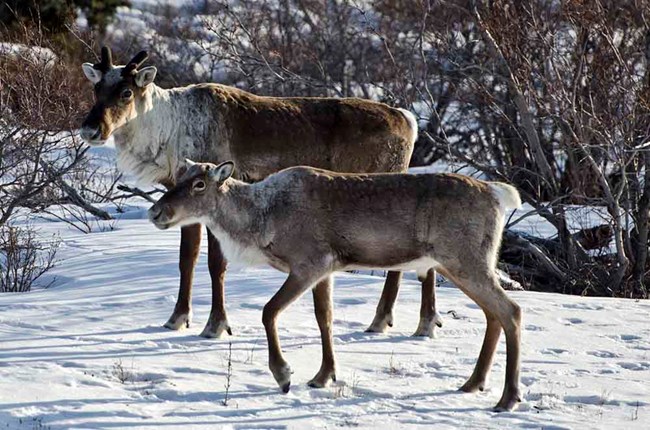Last updated: May 9, 2025
Article
Improved methods of studying animal movement

Wildlife collars provide lots of useful information. Wildlife movement patterns and distribution can tell us about how wildlife use the landscape, different habitats, and the timing for where they go and how long they stay.
Using radio-collared caribou in Denali National Park and Preserve, we explored a method for using high-resolution animal location data to understand broad patterns of animal space use, resource selection, and species distribution. This approach, known as marginalized space-time point processes (mSTPPs), offers a more precise way to understand where animals like caribou choose to live and feed over large landscapes. In the context of studying animal movement, marginalization of time refers to the mathematical process of focusing on the spatial patterns of animal locations while accounting for, but not directly modeling, the timing of those movements.
This method has several advantages:
- Reduces complexity of models by integrating over the time dimension, allowing researchers to focus on where animals spend time without getting bogged down by every individual movement,
- Improves accuracy by capturing broad movement patterns while still accounting for the fact that animals tend to revisit certain areas over time, improving the precision of habitat use estimates,
- Better predictions: this approach leads to more accurate predictions of space use, which can be critical for conservation and resource management.
Marginalising Time in Habitat Selection and Species Distribution Models Improves Inference
Abstract
Aim
Recent methodological advances for studying how animals move and use space with telemetry data have focused on fine-scale, more mechanistic inference. However, in many cases, researchers and managers remain interested in larger scale questions regarding species distribution and habitat use across study areas, landscapes, or seasonal ranges. Point processes offer a unified framework for many methods applied in studies of species distribution and resource selection; however, challenges remain in terms of dealing with temporal autocorrelation common in many types of telemetry data collected from animal locations.
Innovation
Space–time point processes (STPPs) have a unique property, in that marginalising time offers a connection between individual animal movement and broader point processes, yet this property has seen little attention in both statistical and applied research. In this paper, we first present some of the details of this marginalisation property and methods for applying marginalised STPPs (mSTTPs) to autocorrelated telemetry data and then apply a mSTTP in a case study on the summer space use and habitat selection of female caribou (Rangifer tarandus) in Denali National Park and Preserve, Alaska.
Main Conclusions
The case study demonstrated that an mSTPP approach can improve inference over other commonly used methods in terms of its ability to account for temporal autocorrelation and offers greater precision in parameter estimates and improved predictions of space use. As this method fits conveniently into the existing point process frameworks, it offers a practical solution to dealing with temporal autocorrelation inherent to many types of telemetry data when research questions center around broader scale patterns of animal habitat selection and space use.
Eisaguirre, J. M., L. G. Adams, B. L. Borg, and H. E. Johnson. 2025. Marginalising time in habitat selection and species distribution models improves inference. Diversity and Distributions 31(5): e70028.
